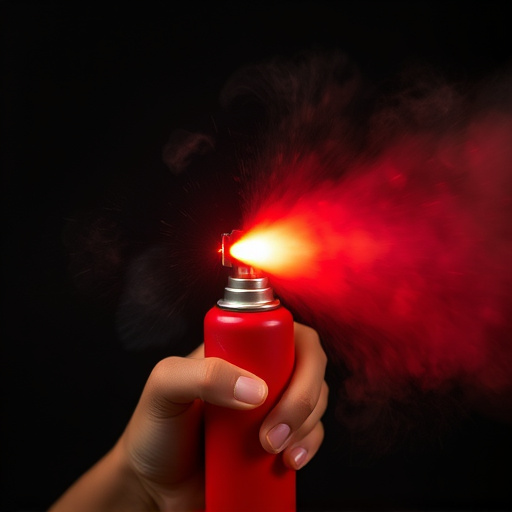Pepper spray, a non-lethal defense tool using capsaicin, ranges from 2% to 5% in strength, with legal limits varying globally. The strongest legal concentration, measured in mg/L, offers powerful self-defense but should be chosen responsibly based on local laws and personal safety needs. Always check regulations, consider factors like range and ease of use, and ensure safe storage and deployment for effective yet responsible protection.
Personal safety is paramount, especially in an unpredictable world. One powerful tool that can offer a critical edge is inflammatory pepper spray. This comprehensive guide delves into understanding how this self-defense mechanism works, exploring legal considerations, and comparing concentrations to find the strongest yet legally acceptable options. We’ll help you make an informed decision and provide safety tips for responsible use, ensuring peace of mind and enhanced personal security.
- Understanding Pepper Spray: How It Works
- Legal Considerations: What You Need to Know
- Comparing Concentrations: Strongest vs Safe
- Choosing the Right Pepper Spray for You
- Safety Tips for Effective and Responsible Use
Understanding Pepper Spray: How It Works
Pepper spray, also known as oleoresin capsicum (OC) spray, is a non-lethal self-defense tool designed to temporarily incapacitate an assailant. It works by irritating the eyes and respiratory system through the activation of specific pain receptors. The key component in pepper spray is capsaicin, the chemical responsible for the heat sensation in chili peppers. When deployed, the spray creates a burning sensation, causing the target’s vision to blur and making it difficult to breathe or move effectively.
The effectiveness of pepper spray lies in its concentration, measured in percent capsaicin. The strongest legal pepper spray concentration typically ranges from 2% to 5%. This concentration ensures that the spray will be potent enough to deter an attacker while adhering to legal guidelines regarding the use of force for self-defense. Understanding how pepper spray works and its available strengths empowers individuals to make informed decisions about their personal safety.
Legal Considerations: What You Need to Know
When considering personal safety and inflammatory pepper spray, understanding legal considerations is paramount. The legality of carrying such a device varies greatly from one region to another, with specific rules governing its use and possession. In many countries, pepper spray is classified as a weapon, subject to strict regulations. For instance, some areas mandate that individuals obtain permits to carry pepper spray, while others restrict the types and quantities permissible.
The strongest legal pepper spray concentration, typically measured in percent capsaicin, is often a point of interest. However, it’s crucial to remember that increased potency doesn’t necessarily translate to more legality. Authorities worldwide have set limits on the maximum concentration allowed for personal use without a prescription or special license. Always check local laws and consult with law enforcement to ensure compliance and maximize your safety while adhering to legal boundaries.
Comparing Concentrations: Strongest vs Safe
When considering personal safety, one of the key factors is understanding the difference between the strongest legal pepper spray concentration and what’s considered safe for everyday carry or specific situations. The capsaicin concentration, measured in milligram per liter (mg/L), determines its effectiveness. Highest concentrations can range from 10% to 2 million mg/L, but not all strengths are legal everywhere.
The “safe” concentration varies based on intended use and local regulations. For general self-defense, a spray with around 2% capsaicin is recommended as it’s potent enough to incapacitate an attacker without causing long-term harm. In contrast, strongest legal pepper spray concentrations are typically reserved for specialized scenarios or law enforcement use due to their intense irritation and potential health risks at higher mg/L levels.
Choosing the Right Pepper Spray for You
When selecting the right pepper spray, understanding your needs and local laws is paramount. The strongest legal pepper spray concentration typically ranges from 2% to 4%, offering a powerful yet controlled dose for self-defense. This concentration ensures maximum effectiveness in neutralizing an attacker while adhering to legal restrictions on occlusive irritants.
Consider factors like range, duration of effect, and ease of use when making your choice. Some sprays offer a longer reach, while others focus on prolonged stun effects. It’s crucial to pick a brand that suits your comfort level and skill set, ensuring you feel confident in its performance during an emergency.
Safety Tips for Effective and Responsible Use
When using personal safety inflammatory pepper spray, it’s paramount to prioritize both effectiveness and responsibility. Start by selecting the strongest legal pepper spray concentration available to ensure maximum impact. Always store the spray in a secure location, out of reach of children and unauthorized individuals. Before deploying, check local laws and regulations regarding its use, as these vary significantly across regions.
Before applying, assess the threat level and consider alternative de-escalation methods if possible. When faced with an attack, aim for the attacker’s eyes, nose, or mouth—these areas are most sensitive to capsaicin. Remember, pepper spray is meant to disrupt and temporarily incapacitate, not cause lasting harm. After use, wash affected areas thoroughly and keep a close eye on any potential side effects or allergic reactions. Responsible use requires awareness and respect for both personal safety and the well-being of others around you.
When choosing a personal safety inflammatory pepper spray, it’s crucial to balance effectiveness with legal considerations. While the strongest legal pepper spray concentration offers robust protection, it’s essential to select one that complies with local laws and regulations. By understanding how pepper spray works, comparing concentrations, and following safety tips for responsible use, you can make an informed decision to enhance your personal security. Remember, knowledge is key to staying safe – arm yourself with the right tool and always use it ethically.
